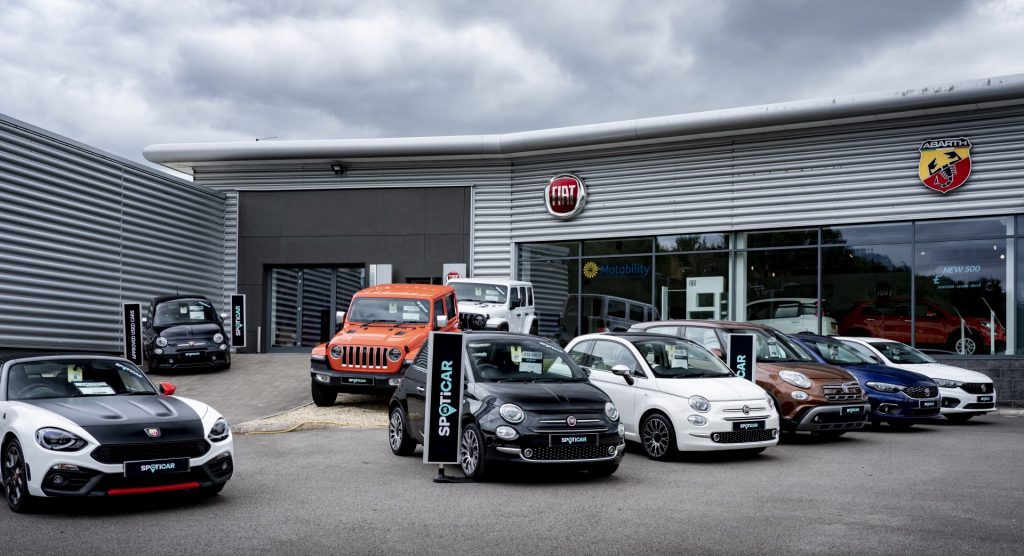
By Guy Bird
Stellantis Group’s Maria Grazia Davino is not your average UK automotive managing director. In a year of car sales and distribution upheaval, she’s taken on one of the toughest jobs in the business. Here she explains what makes her different and how the turnaround starts now
I am expert in logic, that’s my background,” says Stellantis UK MD Maria Grazia Davino, “and my management style is to create strong bridges, bridges that will not break.” Born in the tough Naples neighbourhood of Scampia, the Italian started her automotive career in her early 20s at Lamborghini’s HQ in Sant’Agata – when the Murcielago was on sale and the Gallardo was being planned – while studying for a PhD in Semiotics at the Bauhaus University, in Weimar, Germany. She started as a product manager, then became PA to the (still) president and CEO of Lamborghini, Stephan Winkelmann. But she didn’t finish her PhD – confessing with a wry smile to catching the “automotive illness”. While at the Italian luxury sportscar brand she also took on roles in finance control and sales planning. “There I learned how a car gets conceived, built and sold, learning from the best, that was my luck,” she recalls with obvious fondness.
As a Fiat Chrysler Automobiles (FCA) employee since 2011, under the leadership of Sergio Marchionne, she started in planning and then quickly moved to retail (in the Italian cities of Turin and Rome) before taking on successive CEO country management roles in what were then seen as turbulent operations in Austria, Switzerland and Germany. “Before me, there had been 12 managing directors in ten years in Germany,” she says to provide context. “But I spent four years in that role. I’m telling you – not because of my CV, which I really don’t care about, or like to disclose – but to say this is my background. We worked hard and achieved things. The success is my dealers’ and my people. And the problems are mine.”
As such, Davino is not your average economics scholar or ‘salesman made good’ and is well used to very different products, cultures and management styles. She’s also a forthright interviewee and knows full well that her new UK problems are big ones. After very mixed results in 2023 across the nine brands operating in the UK – Abarth, Alfa Romeo, Citroën, DS, Fiat, Jeep, Maserati and Vauxhall – and an awful result in the NFDA Dealer Attitude Survey of Summer 2023, which saw eight of those brands consistently in the bottom ten places (and Maserati’s dealer views aren’t listed), there’s an awful lot of work to do. To be fair to Davino, she wasn’t in charge when the problems she inherited started, taking on the role officially on 1 September, 2023, after a month of shadowing her predecessor Paul Willcox, who retired from the group.
 “The advantage is that the problems are clear,” she begins. “This is a privileged starting point because at least I know what is to be done. I have a clear agenda with my network. But first I have to respect our professionalism and solve problems. I am referring to the solution of operational problems. It’s very concrete. There are so many things we can and must do better, finding the right balance between legacy operations and new, simpler ways of doing things. And also learning from competitors, why not?”
“The advantage is that the problems are clear,” she begins. “This is a privileged starting point because at least I know what is to be done. I have a clear agenda with my network. But first I have to respect our professionalism and solve problems. I am referring to the solution of operational problems. It’s very concrete. There are so many things we can and must do better, finding the right balance between legacy operations and new, simpler ways of doing things. And also learning from competitors, why not?”
After some gentle prodding, Davino points to various specific issues ranging from the upheaval of the Fiat dealer network ‘transformation’ in the last few years which resulted in the loss of 36 dealers (from 115 to 79), as well as the high price of the key 500 Electric model – “it suffered from pricing that was probably not okay for the market,” she concedes. Currently it’s on offer from £28,195 with a £3,000 Fiat e-Grant saving on top. Dealer numbers by brand also reduced significantly across the Stellantis Group, by 173, from 921 to 748 across 464 sites (as of November 2023). And compounding the group’s problems, the launch of right-hand drive production of the Alfa Romeo Tonale was late and Jeep’s product supply limited.
“So, operational challenges with marketing and in some cases availability, impacted performance,” she confirms. “How am I reacting? The new head of premium, Jules Tilstone, is responsible for Alfa Romeo and DS and has to find the right mix of product, but Alfa has a great reputation and we have to build on it. For DS, we need to find the right route to market, as it’s not performing at the level this brand’s products should. For Jeep we have Kris Cholmondeley, with a strong focus on a smaller network. Also, although Fiat’s network has very much reduced, now we go on an expansion again, with a new set-up. They all need treatment. But they need treatment as much as I need to take care of Vauxhall, Peugeot and Citroen, that have new products leading the electrification of Stellantis. I have to make them all work.”
Stellantis’ top three performing passenger car brands, all posted 2023 year-end sales increases on 2022 within an admittedly bigger overall market. Vauxhall registered 100,417 (for a 5.28% share, up slightly on 2022’s 5.19%); Peugeot sold 62,401 (3.28% up from 3.24%) and Citroën shifted 30,931 (1.63% down from 1.76%). All the other Stellantis brands were at less than 1% each, making for a 11.52% passenger car market share for the overall group.
A brighter star in the Stellantis firmament was the performance of its light commercial vehicle (LCV) products, helped by its strong full-electric van offerings. In the overall UK LCV market, Vauxhall sold 34,632 for a 9.9% share (of which about a fifth were electric LCVs). Citroën came second within the group with 27,382 units (7.9%) and Peugeot third with 26,066 (7.47%). Alongside 6,898 units (1.9%) from Fiat Professional, Stellantis’ total LCV share was a healthier 27.2%, with all brands posting healthy double-digit percentage point year-on-year growth figures.
Of course, it’s not all about the numbers, as Davino makes the case, in relation to the more premium and off-road Stellantis brands. “The relevance of market share for the premium brands is not the same,” she says. “For Jeep, if I had one very bad year but incredible product, my mission is to grow in percentage and satisfaction and product sales. In this sense, every brand contributes in a different way and proportion. The mainstream brands are devoted to a certain job, and the premium brands and Jeep are devoted to another.”

But in relation to the UK Government’s new Zero Emissions Vehicle (ZEV) Mandate coming into force this year, which stipulates that 22% of total sales by brand need to be full EVs to avoid major fines, some Stellantis brands would appear to be in line to do more of the heavy lifting than others. “We have a very large product base to work on so Stellantis is in a good position but we have to fight hard,” she says. “This is an equation with more than one solution. Each single brand has the possibility to comply. If everything happens right, my total is okay. If not everything happens, because market demand is something we can [only] partially lead, I will then need to play with brands.”
What Davino is alluding to, is the small print of the ZEV Mandate that allows brands to overachieve on the sales numbers of PHEVs and hybrids with lower emission levels than each brand’s average fleet CO2 level (which varies) and which can then be used to offset any shortfall on EV sales percentages under 22%. “When I task a brand to meet the market share ambition of being ZEV-compliant they have two levers to play: the CO2 emissions and the EV mix. They have to find the right balance between the two.” On this thorny subject, Stellantis’ head of communications adds: “What we can say, is that we will achieve the ZEV mandate targets this year. We will not buy credits or postpone.”
To succeed in these aims, Stellantis’ UK operation clearly needs to form a more fruitful relationship with its network, which, if the NFDA survey is any guide, was severely damaged in part by the attempt of her predecessors to reduce dealer numbers and change working practices. At the time of Motor Trader’s interview with Davino in late November 2023, the revised plan was to introduce a form of agency model first with Alfa Romeo, DS and the LCV dealers from July 2024. But since then, she has decided to pause any agency model implementation across the board until the end of 2026 and with the involvement of the ICDP consultants as an independent third party, in an attempt to ensure a fairer result for all. This is a considerable back-peddle on what came before but it is backed up by her avowed – and aforementioned – bridge-building management style based on trust and transparency with the dealers that are left and still interested.
She certainly doesn’t seem to be one for business catchphrases for the sake of it. “These are not empty words,” she says firmly. “Transparency to me, means, ‘be clear about your plan, what you ask me and what I can give you.’ I am working to achieve this transparency and the alignment of planets. Because dealers are relevant to me and we are relevant to dealers. You cannot buy trust. We need each other, we have mutual interests and we don’t have time to waste. So, once you acknowledge and share the standing of things, the only thing you can do is move on to get the job done. I also believe in personal relationships. Therefore, I travelled the UK, not only to understand its geography from an operational point of view, but also to meet the people.”
The impression she’s gained has been positive. “It’s a very business-oriented culture here. I see this in the dealers at all levels, not only the owners, which you would expect, but also from the general managers to the sales and aftersales teams, who are very ‘figures’ and performance-minded. They like to compete and want to be better.” The Stellantis Group’s UK operation finished 2023 ranked fourth within Europe, with 314,141 combined passenger car and LCV sales. That’s above Spain (221,332) but behind Germany (390,476), Italy (595,028) and France (634,306). So the UK is still a clear ‘top five’ European player for the global organisation and one that deserves attention and care. During an early January 2024 ‘investor conference’, Davino made an impassioned speech to spur on her dealers and is hoping for more positive results – via crucially better dealer relations – will follow.
When or if she has time to take a break from the enormity of the task ahead, Davino says she likes to read. That now includes English books too – “I’ve been interested in history and geopolitics for many years and this country is beautiful and incredibly interesting to me” – and she also professes a love for the acclaimed social justice and realism films of director Ken Loach. However, there are limits. While appreciating the strength and performance levels in English football and its passionate fans – which she says is the “new reference point” compared to Italian and German equivalents – she says she is still culturally duty-bound to remain a supporter of SSC Napoli football club. That respect for her Italian background perhaps explains her current choice of company car too – an Alfa Romeo Stelvio SUV – and also her classic car crush, a Lamborghini Espada. She’s never owned the latter, but did once buy, of all things, an East German Trabant.
All of which makes Davino an unusual individual. How that different mindset might affect the Stellantis Group’s UK dealer fortunes is still to play out, but there definitely seems to be a steely determination to her character, mixed with a philosophical approach and a pursuit of fairness, informed by her background, education and career to date, that could bode well for Stellantis dealers, both large and small. “All dealers are equal. This has always been my approach if you investigate me,” she says calmly. “If you respect the business, you have to respect businesses of all sizes. The dealer that does the job in a small village is, for the brand, as relevant as a dealer group. Because at the end, the customer is relevant. Would you say a customer for a Fiat Panda is less relevant than an Alfa Romeo Giulia? No, both are relevant. This is my approach.”
 Motor Trader The award-winning and longest running UK magazine for car retailing professionals. Your first stop for News, Jobs and Reports for the motor industry.
Motor Trader The award-winning and longest running UK magazine for car retailing professionals. Your first stop for News, Jobs and Reports for the motor industry.